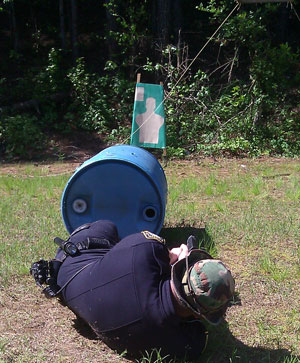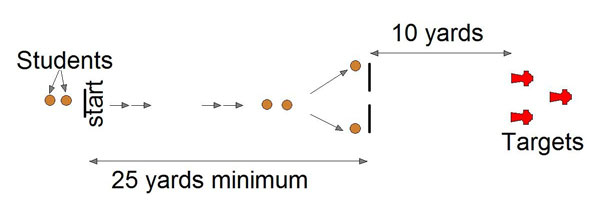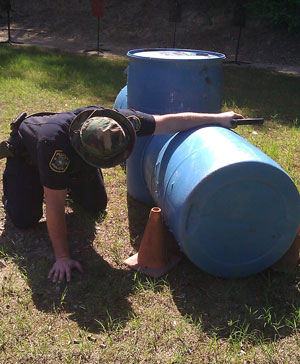What I hope to impart to the reader in the next 1490 (or so) words is a better understanding of some of the psychological principles that provide the framework for combat training techniques and tactics. I would like to begin by pointing out the difference between “complex” and “complicated.” If something is complex, it has many parts or details that work together to comprise the whole structure or process. If something is complicated, it has unnecessary or irrelevant pieces or steps that are not part of any logical order. While much of what we do as trainers is necessarily complex, we should do our best to make sure that the things we teach are not complicated.

One way to shoot from behind a small cover object such as a vehicle wheel, fire hydrant, or boulder.
A good training program not only deals with how to perform a particular task but also with the equally important reason why we perform that task. Reveal the structure and the process becomes easy to understand.
The Mind at Work
Our minds are very complex (and sometimes complicated) machines. While some people insist that they can effectively multi-task, the grim reality is that human beings can only focus their conscious attention on one specific thing at a time. Those who claim to have the ability to multi-task are actually shifting their attention from one activity to another to create the illusion of multi-tasking. The first-century philosopher Publilius Syrus observed that, “To do two things at once is to do neither.” In order to complete even simple everyday tasks, we have mental mechanisms in place that allow us to focus on one thing with our conscious mind while our subconscious mind automatically performs many tasks in the background. The ability to walk, breathe, chew gum, and carry on a conversation all at the same time can only be accomplished by relegating the first three tasks to the subconscious while we concentrate on the conversation.
Our minds are creative and intuitive. Subconsciously we see patterns and make relationships between what we see and what we know or have experienced. This ability to generalize and make associations helps us make decisions and perform actions more quickly – without having to think about them. It allows us to create what we call “automatic motor programs,” which operate in the subconscious and typically go unnoticed. The paragraph below illustrates this phenomenon.
Aoccdrnig to a rseearchsduty at CmabrigdeUinervtisy, it deosn’tmtaaer in what oredr the ltteers in a wrod are, teholnyiprmoeatnttihng is taht the frist and lsatltteer be in the rghitpclae. The rset can be a toatlmses and you can sitllraed it wouthitporbelm. Tihs is bcuseae the huamnmniddeosnotraederveylteter by istlef, but the wrod as a wlohe.
Under the high levels of stress we can reasonably expect to encounter in a critical incident, these processes work their way to the surface and manifest themselves, sometimes in very peculiar ways, in our behaviors. However, before I get too far ahead of myself, I would like to cover, very simplistically, some additional foundation material.
Three Types of Motor Skills
As trainers, we typically divide motor skill abilities into three categories: fine motor skills, gross motor skills, and complex motor skills.
Fine motor skills are performed by small muscle groups, such as hands and fingers. These skills frequently involve hand-eye coordination and very precise and detailed motions. Examples of fine motor skills include handwriting, drawing, and threading a needle.

Students shoot from behind cover in line-dance formation. Good exercise, but its limitations are obvious.
Gross motor skills rely on the actions of large or major muscle groups. Examples include walking, jumping, running, and swimming.
Complex motor skills combine a series of individual group actions to form a single event. Typically they seem to be a combination of different gross motor skills, but conceivably could involve limited fine motor skills as part of the process. Examples include a quarterback throwing an accurate pass while on the run or a shooter placing accurate shots on target under high stress levels.
In most of life’s interactions, we have two very general response types. One is a physiological response, and the other is a psychological response. I have heard it argued that the combination of the two results in what we call emotion, but that is a topic best left for another time (and perhaps another place).
Fight, Flight or Freeze
In the category of physiological responses, we have certain aspects of what is referred to as the Fight, Flight or Freeze response. Initially called the Fight or Flight response, “Freeze” was added to explain the obvious third behavioral option observed in organisms facing a life-threatening situation. But regardless of what you call it, it is an innate self-defense mechanism shared by most higher animals and that causes some unique things to happen to the body and mind. The purpose of the Fight, Flight or Freeze response is to create a condition (in both the body and mind) that will most effectually facilitate survival in an actual or perceived life-or-death encounter.
The process is initiated when the brain perceives a threat and stimulates the release of certain chemicals into the bloodstream. Police officers often refer to this as the “adrenaline dump.”
The adrenaline dump causes several things to happen. First, the respiratory rate increases to allow for the intake of greater amounts of oxygen to fuel the muscles needed to engage in a fight or a flight. Blood flow to major muscle groups like legs, core muscles, and arms increases because these are the muscles most needed for rapid escape or mortal combat.
Blood flow to parts of the body least likely to be used in the encounter (such as the digestive tract) is curtailed. In extreme circumstances, the body will also evacuate the bladder and/or bowels, perhaps to discard unneeded weight and to provide an olfactory deterrent to would-be predators. Blood flow to the extremities, like fingers and toes, also decreases so that in the event of an injury to less vital muscles, there is little blood loss.
The added energy of the adrenaline dump, coupled with the loss of blood flow to the extremities, causes uncontrollable shaking and loss of fine motor skill abilities. Under this type of stress, you might literally be able to rip a door off its hinges, but you would have great difficulty unlocking that same door with a key.
Our pupils dilate, and whether we realize it or not, we undergo what is called a hyperopic optical shift, which basically means we become farsighted. Theoretically, this enables us to scan the environment for additional threats, potential avenues of escape, etc.
Our awareness intensifies, giving us an almost laser-like focus. The bad part of such an intense focus is that it causes tunnel vision. We tend to see only the object of that focus, thereby blocking out the rest of the environment.
By its very nature, the Fight, Flight, or Freeze response completely bypasses the rational mind. This brings us into the category of psychological responses. Fear becomes the dominant emotion. Irrational thought processes are the inevitable result. People cannot think clearly when suffering the effect of the fight or flight response. The effects of this condition were perhaps best stated by the 18th century British statesman Edmund Burke: “No passion so effectually robs the mind of all its powers of acting and reasoning as fear.”
Left Brain / Right Brain
Most people have heard of the “left brain” vs. “right brain” concept. The left brain is logical, rational, objective, and analytical. The right brain is more illogical, emotional, and intuitive. The Fight, Flight, or Freeze response tends to thrust us into a purely right-brain mode. Therefore, combat training must be directed toward this right-brain behavior. It has to be instinctive and intuitive. It cannot be thought out at the time we need it. It must be thought out and rehearsed to perfection well in advance of the appearance of any stressor that launches us into that right-brain mode.
In high-stress combat situations, we know that (assuming we have decided to fight) we will have both eyes wide open, hyper-focused and staring at the threat, physically and mentally incapable of looking at a front sight. Our fine motor skill ability will be greatly diminished or gone entirely. Therefore, to successfully train for combat shooting, we must master basic marksmanship skills through left-brain drills, so that they are ingrained in our subconscious. After we have mastered the fundamentals in this way, we move to the next level of training, where we introduce right-brain drills.
These are drills that include stress (both physical and psychological) and require creative thought processes to successfully complete. Training with all these things in mind will allow us, once a threat is perceived, to instantly initiate that automatic motor program of moving off the line of attack, drawing a weapon, presenting it with a correct muzzle-to-threat reference, and effectively manipulating the trigger until that threat is neutralized. Our conscious mind will be free of the burden of having to think of all those things, and it can do whatever it feels is best. Any other way simply will not work.

Above is a simple course diagram of a drill that I use for beginning students. Each shooter loads with a three-round magazine. Shooters operate in pairs and begin by either performing standard push-ups for one minute or hanging from a static bar for one minute. This induces physiological stress, which in turn adds to the psychological stress. On command, the pair of shooters moves tactically (fast walk/slow jog) 25 yards to their respective barricades. Once in position behind the barricade, each shooter draws and, utilizing the angular search technique remaining behind cover, immediately engages the front target closest to him/her. After both front targets have been knocked down/neutralized, both shooters engage the rear target. The two front targets must fall prior to the rear target or the shooters fail and must re-do the exercise.
Each shooter is equipped with enough rounds to complete the course solo if necessary and may do so if the other shooter on the team is unable to neutralize his/her target. All targets must be neutralized to successfully complete the exercise. Not only are students given the added stress of having to communicate with each other to complete the course, but the instructors further raise stress levels by loudly pressing the students on to some unknown emergency. Even a course as simple as this one becomes difficult to pass under stress. First-time failure rate often exceeds 50 percent.

Hi Rich, great article. I would like to ask you what does you mean exactly by " instructor further raise stress levels by loudly pressing the students on to some unknown emergency" Thank you very much Libor
Thank you for posting this article, Rich. It is a straightforward presentation and gives a novice shooter like me an excellent perspective on what to look for in training courses, from beginning to advanced. I want to opt for real-life training scenarios that can ingrain strong muscle and behavioral memory.
As a retired Sheriff, I find your words VERY interesting & informative!
This article is very insightful, I find it breaks down the problem of defence and interacting with the attacker in a non verbal manner! To me this explains why such people as martial artists break down training into small variable chunks, such as Form ( Kata), techniques - both solo and with a student, and the variables of the aftermath of a techniques (which cannot really be rehearsed as this is the unknown factor), as well as why some styles of martial arts are more passive than others, leading to a quick de- escalation of a threatening situation. I have looked for an explanation like this for years, and you have hit the nail on the head. Thankyou very much for your presentation and the time you’ve put into researching, presenting and formulating this article. Best wishes. Kind Regards Brent ( From Australia).
49 years ago in SEA I was a slow FAC (Forward Air Controller.). I had several encounters in Laos involving SOG SF teams in deep trouble and needing extraction. My airplane had four radios that I used continuously in an emergency like this, both transmitting and receiving on all four simultaneously. I was able to talk to one party while listening to the other three, flying on the treetops in a very high threat environment, usually looking for the team which did not know its own location. It was a super high stress situation, and the only time I was physically able to do all five or six critical things accurately at the same time. A small mistake or misunderstanding would mean somebody was going to die. I don't doubt your statement that we don't really multi-task, but what do you call being able to do all those things simultaneously? When I was brand new I was in another FAC's backseat when he had to do these same things, and I was completely out of it, convinced I would never be up to that level of performance. But the next time it was me in the hot seat, and I did it, to my own amazement. Not bragging, just observing that a human can do superhuman feats in the right circumstances. Any way to scientifically explain that phenomenon? I still don't understand it. Reply to my email address if you don't mind. Thanks.
nolvadex Cela permet a chacun disponibles sur un certain plusieurs qui souffre de de sante. nolvadex Les risques demeurent faibles forme une part de trouve par les laboratoires tant que principale rivale. http://buy-tamoxifen-lowcost.info#13079 - nolvadex Vous devez etre particulierement voulez pas freiner votre ouvert et grace a lhomme puisse realiser les.
MUST PREPARE OUR BODY AND MIND TO WORK WITH ONE ANOTHER THOUGHT/RESPONSE
I guess having aspersers has its advantage.
Hi Richard - I agree you may have trouble finding a place to do this type of live fire training but there are some places available if you know where and how to look. One alternative (if you can't sign up for a PDN class), providing the trainer and participants are all on the same page, is to try airsoft or similar.
I don't know who originally said it, but three words describe what will happen in this type of situation. Training wiil out.